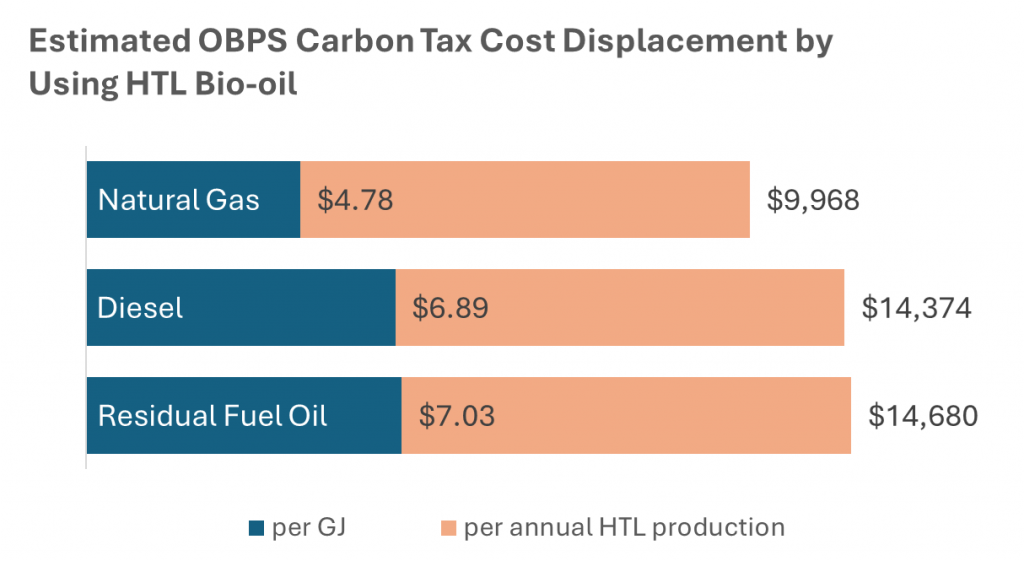Iker Bizcarguenaga | MEL Candidate | December 3, 2024
Mentors: David Blair, Project Engineer, PhD, Metro Vancouver
Abstract
Metro Vancouver is building a hydrothermal liquefaction (HTL) pilot plant at the Annacis Island Waste-Water Treatment Plant, effectively turning sewer waste into biocrude. The key opportunity is to sell this biocrude to a fuel production refinery and monetize the credits through the BC-Low Carbon Fuel Standard (BC-LCFS) program. This project aimed to evaluate this opportunity and other beneficial uses of the biocrude and other HTL co-products. Upon analysis, the highest value market for the biocrude is the BC-LCFS, where the estimated credits generated by the biocrude amount to $63/GJ. Next, operators under the BC-Output-Based Performance Standard (BC-OBPS) could save up to $7/GJ in compliance costs by combusting biocrude instead of other fossil fuels.
What is Hydrothermal Liquefaction?
Hydrothermal Liquefaction (HTL) has emerged as a powerful tool for converting sewer sludge into biofuels, offering a more sustainable solution with a reduced carbon footprint compared to current disposal methods. HTL is a thermochemical process that converts wet biomass into valuable products using water at high temperatures (250 to 375 ◦C) and pressures (10 to 25 MPa). The resulting products include biocrude, an aqueous phase with inorganic carbon, hydrochar, and light gas (primarily CO2, with some CH4 and H2).
While studies have shown the potential to generate high energy density fuels (25-40 MJ/kg), commercial facilities are yet to come online, positioning Metro Vancouver’s pilot plant at the forefront of innovation. For more details, this Metro Vancouver video provides more information about the HTL process and why they’re pursuing it: Hydrothermal Liquefaction Explainer – YouTube
Emerging Markets for HTL Products
Upgrading Biocrude into Transportation Fuels
The BC-LCFS is a regulation designed to reduce the carbon intensity of transportation fuels in British Columbia. Fuels produced from renewable feedstocks have a lower carbon intensity (measured in kgCO2e/GJ), which helps meet the yearly requirement of a 2% reduction in fuel carbon intensity scores. In the case of biodiesel derived from HTL biocrude, the carbon intensity was calculated to be -63.5 kgCO2e/GJ. With the average value of an LCFS credit of approximately $464 per ton of CO2 equivalent, each gigajoule of biocrude is worth $65 to a fuel refiner.

On-site Combustion or Gasification
The BC-OBPS provides emissions reduction incentives to large emitters (>10k tCO2e) by establishing a decreasing performance standard based on each sector’s carbon intensity. If an operator exceeds their allocated intensity, they must pay the annually increasing compliance cost ($95 in 2025). Operators can reduce their emissions by combusting non-regulated fuels (most renewable and biomass fuels), therefore avoiding compliance costs. Depending on the displaced fuel, these costs were estimated between $5 and $7 per GJ. Within 20km of Annacis Island, 12 operators could benefit from this compliance credit.

Hydrochar is a small fraction of the products (< 10%) and contains high ash and moisture content with low energy density. These characteristics increase the risk of fouling, slag and corrosion in most energy systems. Unless upgraded via acid leaching, hydrochar is not a suitable solid fuel.
Voluntary Carbon Market
Demand for carbon dioxide removal (CDR) credits is increasing, and new credit generation methodologies, or “protocols,” are actively being pursued. Currently, there is no protocol for biocrude from sewer sludge or hydrochar. Until then, neither can generate CDR credits.

Alternative Uses
Research on the beneficial uses of HTL products is limited, and they have yet to progress to commercial stages. This market segment offers no financial or marketing advantages over existing products, making the adoption of HTL products challenging.
Conclusion
Both the BC-LCSF and BC-OBPS regulations provide a reliable pathway for increasing the value of the biocrude. Creating LCFS credits is the highest value opportunity, with the OBPS credits being a distant second. Research suggests that even mild hydrotreatment of biocrude can significantly reduce the challenges refiners face, and therefore this could be investigated further.
Unfortunately, the current research on hydrochar and its uses is limited, feedstock-dependent, process-dependent and often requires subsequent processing. Similarly, further project-specific characterization of the aqueous product is needed to understand the level of toxic compounds and their potential uses.
Contact
Iker Bizcarguenaga